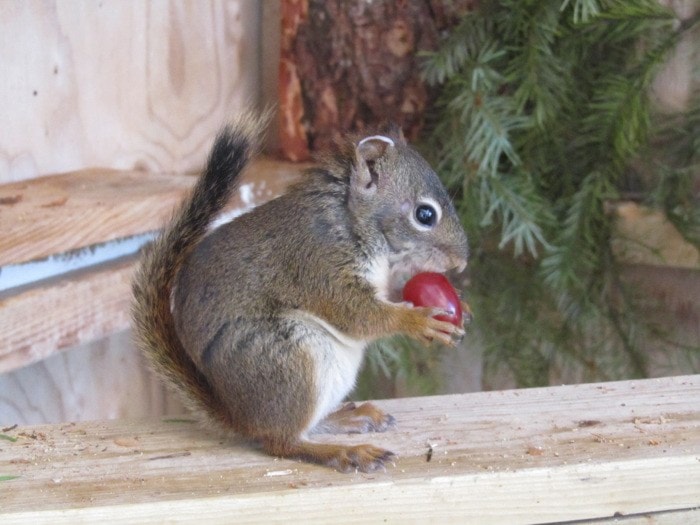Fall is a time for collecting and harvesting food for the long winter ahead.
This is especially important for many wildlife species whose survival depends upon the food supplies they have gathered.
This summer MARS rescued five baby squirrels that were only a few days old and had just opened their eyes when their tree nest was destroyed. We suspect the mother died along with three of the babies.
Ultimately only one baby survived the ordeal being hand-fed, weaned and provided with a habitat that replicated the wild.
Red squirrels are part of the Rodentia family of which there are 365 species worldwide that also include Prairie dogs and chipmunks.
The most common squirrels on southern Vancouver Island are the eastern grey (including the black); North American red, only found on the North Island; the Douglas squirrel that is not found on the Mainland and the flying squirrel that is found on some of the smaller islands.
Squirrels are opportunistic feeders and this has helped them maintain healthy populations; unfortunately there have been sightings of the grey squirrel in our area which will eventually lead to a decline of our native red squirrel.
Red squirrels have rusty red coats that are shed twice a year; their bellies are buff-coloured. Their most distinguishing feature is their coal black eyes that are circled with white.
Grey squirrels do not have highlighted eyes and their bellies are white. Although the red squirrel tails are bushy, they are not as full as the grey. Their tails are used for balance when jumping or climbing through the trees.
These animals are very agile with powerful hind legs and curved front claws that enable them to hang upside down on branches or run down tree trunks. Front feet are used to hold on to their food and are very dextrous rotating the nuts and seeds to retrieve the fruit inside.
Very vocal, squirrels can clearly be heard throughout the forest as they ward off predators. Their chatter includes growls, screeches, buzzes and chirps that are often accompanied by foot stamping and tail jerking.
Found in coniferous and deciduous forests they have adapted to urban and city life; they enjoy a variety of foods including, nuts, fruits, green pine cones, fungi, insects, birds and eggs.
Another unusual food source is found in the maple trees. The squirrel will bite into the tree bark, releasing the sap. They will then wait until the water evaporates, leaving behind a tasty sugary morsel of concentrated sap.
Pine cones will be buried in damp soil and the nuts and seeds in "middens" to sustain them through the winter. One wonders how they remember where they have stored all their goodies; quite simply they mark the locations with their scent enabling them to find the exact spot of the hidden food.
Squirrels are an important part of the health of the forest as they disperse and scatter seeds from trees and plants regenerating the forest. Red squirrels are very solitary creatures with a small, fiercely defended territory.
The squirrel that is still residing at MARS is now an inquisitive teenager learning its survival skills and how to open acorns, nuts, pine cones and other natural food sources. It is still figuring out what to do with the food but shows definite signs of hoarding, which is a natural instinct they inherit.
Hopefully, we will be able to reintroduce the squirrel into a nearby location where we will continue to provide a supply of food; this will supplement the food it finds for itself until it feels comfortable enough to be self-sufficient at which time it will take off to find its own territory.
Please remember that although squirrels are "oh so cute," they can be a pest if they decide to get into your attic or basement to escape the cold, they will happily chew through wood and wires that can create a household problem.
Do not handle squirrels; they do have very sharp teeth and claws. Please be on the lookout for non-native grey squirrels (very bushy tails and no white eye liner). They have been seen in our area and we would appreciate a call if you see one.
These squirrels are very aggressive and prolific and could potentially lead to the decline and disappearance of the native red squirrel. In addition, they are destroying the endangered native Garry oak ecosystems.
• • •
Watch out for deer on the roads. They are growing their drab winter coats and are very tough to spot, especially when the clocks go back at the end of the month.
• • •
To report injured wildlife, call 1-800-304-9968. For all other calls, phone 250-337-2021 or visit www.wingtips.org.
Sandy Fairfield is the educational co-ordinator for the Mountainaire Avian Rescue Society (MARS). The MARS column appears every second Friday.
